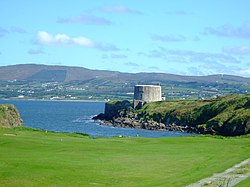Lough Swilly
Lough Swilly is a glacial fjord or sea lough slicing into the coast of County Donegal. It cuts between the western side of the county's Inishowen Peninsula and the Fanad Peninsula, in County Donegal. Along with Carlingford Lough and Killary Harbour it is one of three clear glacial fjords in Ireland.
The name of the lough is from the Iris language, in which is is named Loch Súilí, meaning "Lake of Shadows" or "Lake of Eyes".
At the northern extremities of the lough are Fanad Head with its famous lighthouse and Dunaff Head. Villages on the lough include Buncrana on Inishowen and Rathmullan on the western side. At the southern end of the lough lies Letterkenny.
The lough is also famous for its wildlife-watching (dolphins, porpoise, sea birds, migratory geese and swans) and diving on the numerous ship wrecks, including the SS Laurentic sunk by a German mine (or possibly a torpedo), which went down with 3,211 ingots of gold, of which 3,191 were recovered.
In the south of the lough, a number of small islands (Burt, Inch, Coney, Big Isle) were poldered and the land reclaimed during the 19th century for agriculture and the Londonderry and Lough Swilly Railway constructed embankments on the line from Londonderry to Letterkenny. These reclaimed lands are now regarded as one of Ireland's premier wetlands for wildlife conservation and birdwatching, supporting over 4,000 Whooper Swans and thousands of geese; Greenland white front, Barnacle, Greylagg and Brent geese.
Historical interest
Steeped in history the lough and the Grianán Ailigh hill fort (early fortification and palace dating from 2000–5000 BC) at its southeastern bend was recorded on Ptolemy's map of the world. It has numerous early Stone Age monuments and Iron Age fortifications along its shores as well as a number of shell middens dated to approximately 7000 BC. It is most famous for being the site of the Flight of the Earls. After a failed uprising, in September 1607, Hugh O'Neill, 2nd Earl of Tyrone and Rory O'Donnell, 1st Earl of Tyrconnell, the last Gaelic chieftains in Ireland, set sail from Rathmullan with ninety of their followers.
During a gale on 4 December 1811, the Royal Navy 36-gun Apollo class frigate HMS Saldanha was shipwrecked in Lough Swilly. There were no survivors out of the estimated 253 aboard, and some 200 bodies washed up on shore.
Due to its natural shelter and impressive depth the lough was an important naval port. In October 1798, during the French Revoluionary War, a French republican fleet carrying Wolfe Tone of the United Irishmen, plus troops to assist in 1798 rebellion, was intercepted and defeated in a naval battle at the entrance to Lough Swilly. Subsequently Tone was captured and taken ashore at Buncrana on the east side of the Swilly.
A subsequent reassessment of the threat of invasion led to the building of a series of fortifications guarding the different approaches and landing points within the lough which were completed between 1800 and 1820. Martello towers were built around 1804 to defend the approaches to Londonderry. The six on the lough were armed with smoothbore cannon, firing round shot and were completed in six months.
As the storm clouds gathered before the First World War, the War Office improved the Napoleonic forts and their armaments as well as adding an additional fort at the entrance to the lough at Lenan Head with 9 inch guns (12-mile range) – the largest in Ireland at the time. The remains of these fortifications can still be inspected at Lenan Head, Fort Dunree (now a military and wildlife museum), Ned's Point, Buncrana, Inch Island and on the west coast at Rathmullan, Knockalla and Macamish Point.
During the First World War, the lough was used by the Royal Navy as an anchorage for ships of the Grand Fleet, an amalgamation of the pre-war Home and Atlantic Fleets, under Admiral Jellicoe and a gathering/staging point for Atlantic convoys. During this period a boom was placed across the lough between Macamish and Ned's point, supported by a number of trawlers to prevent U-Boat attacks. After the Irish War of Independence the lough was also one of the Treaty Ports specified in the Anglo-Irish Treaty until its final handing over at Fort Dunree in 1938.
According to exhibits at Fort Dunree, during the Second World War Irish troops manned the guns there with explicit instructions to fire at any ship that might threaten Irish neutrality by entering the natural harbour. There was reportedly only one serious incident, when a Royal Navy ship entered the lough and did not initially respond to signals that it should turn back. However, the ship turned around before Irish forces fired upon it.
See also
| ("Wikimedia Commons" has material about Lough Swilly) |

